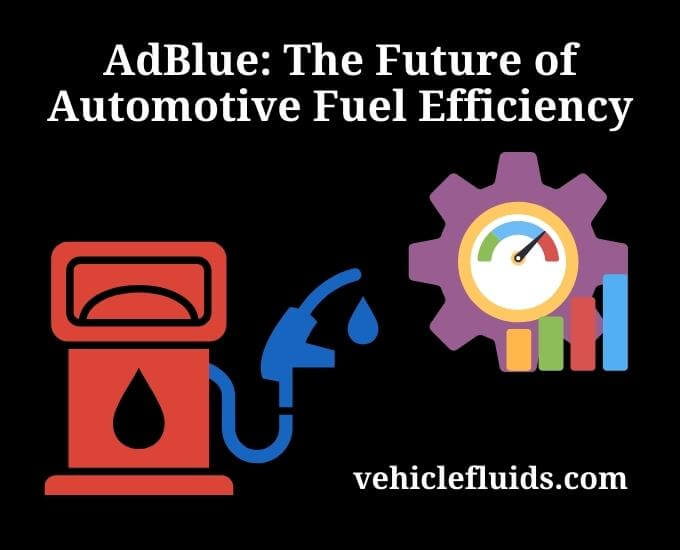The automotive industry is one of the largest contributors to air pollution worldwide. Diesel-powered vehicles, in particular, are known for producing harmful emissions that have adverse effects on both the environment and public health. To combat this problem, many automakers have turned to AdBlue, a solution of urea and water that’s injected into the exhaust system of diesel-powered vehicles to reduce nitrogen oxide (NOx) emissions.

AdBlue has become a popular solution for reducing emissions in diesel-powered vehicles and is now used in many parts of the world. It’s also become mandatory in some regions, such as Europe, for all new diesel-powered vehicles. The use of AdBlue offers several benefits, including reduced emissions, improved fuel economy, and longer component lifespan, among others.
What is AdBlue?
AdBlue is a synthetic liquid that is used as a diesel exhaust fluid in modern diesel vehicles to help reduce harmful emissions. The liquid is composed of 32.5% high-purity urea and 67.5% deionized water. The high-purity urea is produced synthetically from natural gas or coal, and the deionized water is purified water that has had all of its ions removed. The liquid is clear, non-toxic, and non-flammable.
AdBlue is injected into the exhaust system of diesel-powered vehicles, typically downstream of the diesel oxidation catalyst and diesel particulate filter. It reacts with the nitrogen oxides (NOx) in the exhaust fumes and converts them into harmless nitrogen and water. This process is known as selective catalytic reduction (SCR).
AdBlue is stored in a separate tank on the vehicle, typically located next to the diesel tank. The size of the AdBlue tank varies depending on the vehicle and its expected usage. A gauge on the dashboard or in the infotainment system displays the AdBlue level, and the driver is typically alerted when the AdBlue level is low.
AdBlue is an essential part of meeting emissions regulations for diesel vehicles. In Europe, the use of AdBlue is mandatory for all new diesel-powered vehicles. The United States is also expected to implement similar regulations in the coming years.
How Does AdBlue Reduce Nitrogen Oxide Emissions?
AdBlue is a urea-based solution that is used in diesel engines with selective catalytic reduction (SCR) technology to reduce nitrogen oxide (NOx) emissions. Here’s how it works:
Injection
AdBlue is injected into the exhaust system, where it mixes with the exhaust gases.
Reaction
The AdBlue solution reacts with the NOx in the exhaust gases, causing it to break down into harmless nitrogen and water vapor.
Conversion
This chemical reaction is facilitated by a catalyst, which is typically made of a material like platinum or palladium. The catalyst helps convert the NOx into nitrogen and water vapor.
Reduction
The end result is that the NOx emissions are greatly reduced, sometimes by as much as 90%, which makes the diesel engine much cleaner and more environmentally friendly.
The use of AdBlue and SCR technology has been an effective way to reduce the amount of NOx emissions produced by diesel engines, which has led to improved air quality and reduced pollution.
Benefits of AdBlue
Using AdBlue in diesel-powered vehicles offers several benefits, including:
Reduced Emissions
AdBlue is highly effective in reducing nitrogen oxide (NOx) emissions, which are a major contributor to air pollution. When AdBlue is used, vehicles can reduce their NOx emissions by up to 90%.
By reducing these harmful emissions, AdBlue can help improve the quality of the air we breathe and reduce the impact of transportation on the environment.
Improved Fuel Efficiency
By reducing emissions, AdBlue can also help to improve the fuel efficiency of a vehicle. This is because engines with lower emissions tend to be more efficient. The use of AdBlue can improve fuel economy by up to 5% on average, which can result in significant cost savings for vehicle owners.
Longer Lifespan of Vehicle Components
The use of AdBlue can also help to increase the lifespan of certain vehicle components. For example, the catalytic converter, which is responsible for reducing harmful emissions, can last longer when AdBlue is used. This can result in cost savings for vehicle owners as they won’t need to replace these components as frequently.
Compliance with Emissions Regulations
AdBlue is an essential component for diesel-powered vehicles to meet emissions regulations. In many regions, such as Europe, the use of AdBlue is mandatory for all new diesel-powered vehicles.
By using AdBlue, vehicle owners can ensure that their vehicle is compliant with local emissions regulations, which can prevent costly fines and penalties.
The use of AdBlue can help to create a cleaner and more sustainable future for transportation. It reduces harmful emissions, improves fuel efficiency, and can result in cost savings for vehicle owners.
AdBlue in the Automotive Industry
AdBlue has become an important part of the automotive industry, especially in regions where strict emissions regulations are in place. In Europe, for example, AdBlue usage is mandatory for all new diesel-powered vehicles. The United States is also expected to implement similar regulations in the coming years.
AdBlue is used in a variety of vehicles, including passenger cars and heavy-duty trucks. Heavy-duty trucks, in particular, have seen significant benefits from using AdBlue. With the increasing demand for freight transportation, the use of AdBlue in heavy-duty trucks has become an important factor in improving fuel efficiency and reducing emissions. It’s important to know that the smell of fuel inside a car can be a cause for concern, especially if the odor is strong and persistent.
What Are the Potential Risks of Using AdBlue?
While AdBlue is generally considered safe when handled and used correctly, there are some potential risks associated with its use:

Corrosion
AdBlue can be corrosive to some metals, so it is important to use the right materials in the storage and handling equipment, as well as in the engine components that come into contact with it.
Contamination
AdBlue is highly susceptible to contamination, which can reduce its effectiveness and potentially damage the engine components. Contamination can occur if AdBlue is exposed to dust, dirt, or other foreign substances during storage, handling, or transportation.
Freezing
AdBlue can freeze at temperatures below -11°C, which can damage the storage and handling equipment, as well as the engine components.
Health Hazards
AdBlue is a non-toxic substance, but it can cause irritation or harm to the eyes, skin, or lungs if it comes into direct contact with these areas. It is important to follow proper handling and storage procedures to avoid these potential health hazards.
Cost
Using AdBlue can add an additional cost to operating a diesel vehicle, as it needs to be purchased separately and refilled periodically. This cost may vary depending on the size of the vehicle and the amount of AdBlue required.
How to Use AdBlue?
Using AdBlue in diesel-powered vehicles is a relatively simple process, and vehicle owners can take several steps to ensure that they use it effectively:
Check AdBlue Levels Regularly
Most diesel-powered vehicles that use AdBlue are equipped with a gauge or indicator that displays the AdBlue level. It’s important to check the AdBlue level regularly, particularly before long trips or journeys. The AdBlue tank should be refilled before the level drops below 25% to ensure that the vehicle continues to operate normally.
Refill the AdBlue Tank
Refilling the AdBlue tank is a simple process that can be completed at most fuel stations or automotive stores. The AdBlue tank is typically located next to the diesel tank, and the filler neck is typically marked with a blue cap. Vehicle owners should only use AdBlue which meets ISO 22241 specifications to ensure that it’s of the correct purity.
Avoid Contaminating the AdBlue
It’s important to avoid contaminating AdBlue with other substances, such as diesel or oil. This can cause AdBlue to lose its effectiveness or even damage the vehicle’s exhaust system. Vehicle owners should use a clean funnel when refilling the AdBlue tank and should avoid overfilling to prevent spillage.
Be Aware of Cold Weather Conditions
In cold weather conditions, AdBlue can freeze if it’s exposed to temperatures below -11 degrees Celsius (12 degrees Fahrenheit). If the AdBlue freezes, it can damage the vehicle’s exhaust system. To prevent this, vehicle owners should ensure that the AdBlue tank is always at least half full and should park the vehicle in a warm location during cold weather.
Address Any Malfunctions Promptly
If the vehicle’s AdBlue system malfunctions, the vehicle may not be able to operate normally. This can cause the vehicle to enter into a reduced power mode or even stop completely. Vehicle owners should address any malfunction warnings promptly and take the vehicle to a qualified technician for repairs.
By following these simple steps, vehicle owners can ensure that they use AdBlue effectively and maintain their vehicle’s performance and compliance with emissions regulations.
FAQs
Is AdBlue Only Used in Certain Types of Diesel-powered Vehicles?
No, AdBlue is used in most modern diesel-powered vehicles, including cars, trucks, buses, and other heavy-duty vehicles. In many regions, such as Europe, the use of AdBlue is mandatory for all new diesel-powered vehicles.
Where Can I Buy AdBlue?
AdBlue can be purchased at most fuel stations and automotive stores. It’s important to ensure that the AdBlue meets ISO 22241 specifications to ensure that it’s of the correct purity.
What Happens if I Run Out of AdBlue?
If the AdBlue tank runs out, the vehicle will enter into a reduced power mode, and it may not be able to operate normally. It’s important to refill the AdBlue tank before the level drops below 25% to ensure that the vehicle continues to operate normally.
Can I Mix Adblue With Other Substances, Such as Diesel or Oil?
No, it’s important to avoid contaminating the AdBlue with other substances, as this can cause it to lose its effectiveness or even damage the vehicle’s exhaust system. Vehicle owners should use a clean funnel when refilling the AdBlue tank and should avoid overfilling to prevent spillage.
Conclusion
AdBlue is a crucial component in the fight against air pollution and improving fuel efficiency in diesel-powered vehicles. Its use offers several benefits, including reduced emissions, improved fuel economy, and longer component lifespan, among others. As emissions regulations continue to become stricter, the use of AdBlue is likely to become even more widespread in the automotive industry.
Using AdBlue requires some basic knowledge and care, including regular checks of AdBlue levels, refilling the AdBlue tank, avoiding contamination, being aware of cold weather conditions, and addressing any malfunctions promptly. Vehicle owners who use AdBlue effectively can enjoy the benefits it offers and contribute to a cleaner and more sustainable future for transportation.
